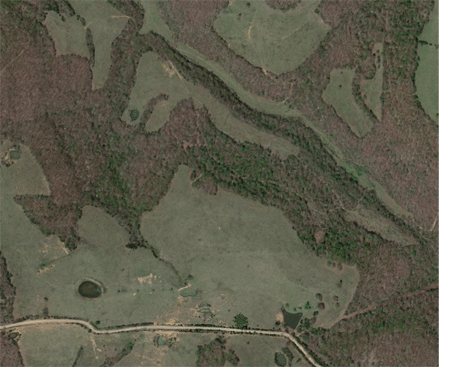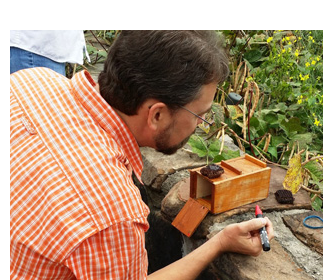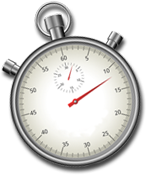Contact
Assistant Professor of Apiculture & Urban Entomology
Phone: 501-671-2222
Fax: 501-671-2252
Email: jzawislak@uada.edu
Web: uaex.uada.edu/bees
University of Arkansas System
Division of Agriculture
Cooperative Extension Service
2601 N. Young Ave.
Fayetteville, AR 72704
What is bee lining?
Bee lining (also known as “bee coursing” or “bee hunting”) is the practice of following a honey bee back to its nest in order to locate a feral bee colony in a tree.
- Bee lining has been a traditional method to locate bee trees in the wild, which could then be opened and robbed of honey.
- The practice was popular in the past when beekeeping was less common, extracted honey was in shorter supply, and “wild” bees were more plentiful. (The term “wild” bees is common but inaccurate. Because the European honey bee, Apis mellifera, is not native to North America, non-managed colonies here are considered “feral” rather than “wild” since they have escaped domestication.)
Currently, with honey bees increasingly threatened by parasitic mites, diseases, and other environmental pressures, people are encouraged to leave bee colonies alone when they are found to be thriving in the wild.
If these colonies are able to survive without human assistance, then their genetic lines should be allowed to continue. The drones produced by surviving colonies will help improve local honey bee populations. Also, healthy colonies will usually swarm each year, allowing these survivor colonies to expand into the surrounding environment. Beekeepers wishing to obtain survivor stock for their own apiaries are discouraged from attempting to trap out or cut out feral colonies from tree bees.
Attempts to remove the bees from a tree too often results in the death of the queen and the loss of a successful genetic line. Rather, beekeepers should allow known feral colonies to thrive, and hope to capture swarms that naturally emerge.
If you know the location of a feral colony, take regular walks through the area during the spring swarm season in hopes of spotting a swarm.
You could also place swarm traps or bait hives around to entice the bees to take up residence in a portable container. Homeowners with feral tree-dwelling colonies are encouraged to live with the bees, but if they believe the bees pose a threat, they can contact a local beekeeper for advice. Feral colonies that reside in the walls of homes or other structures should be removed by competent beekeepers with adequate construction experience, or by beekeepers working with a competent contractor.
In the past, when bee trees were hunted as sources of honey, the tree would usually be marked so that the honey could be retrieved later in the year when it would be ripe. Sometimes the bees could be captured and transferred to another hive, but often the bees would simply be chased away with smoke, and their nest destroyed in the process. Depending on the time of year, these bees might have been able to rebuild their nest and survive the winter, or the colony may have died out. Landowners were often pleased to allow others to remove bee trees for a share of the honey. Hollow trees were generally considered worthless for timber, and once the bees were gone, it could be used for firewood.
Today, with both honey and bees easily available for purchase, bee lining has been relegated to a sport or hobby activity, although perhaps an unusual one.
Hunting a wild bee colony can be a fun and rewarding way to enjoy a day outside. It can be compared to geocaching, but instead of finding an object hidden by other people, bee hunters try to find a treasure hidden by nature itself.
Numerous techniques have been devised to track honey bees to their hives. The term "bee lining" refers to the behavior of the honey bees which, after completely filling their honey crop with food or water, will fly directly back to their hive. This is origin of the phrase “make a bee line.”

Swarms of honey bees can establish new colonies in any suitable cavity. They are
often found in hollow trees, but they may also make themselves at home in walls or
other man-made structures.
Sighting a bee line
In hot weather, honey bees collect water which they use to cool their hives. Water foragers can be found along creek banks and the edges of ponds. Watching the direction of flight as each of these bees returns to home can indicate of the direction to their nest along that line of sight. The direction the bees fly away toward the horizon is known as their vanishing bearing, and can be sighted using a pocket compass to determine the precise direction. Bee hunters can also set out a bait station. By placing a small dish of sugar syrup in the open, people can attract scout bees to stop and feed, and then watch them fly toward home. With luck, the scout bee will soon return with other foragers she has recruited from her hive. With more bees visiting the bait, it can be much easier to establish the direction of a bee line to their hive. It is not uncommon to attract bees from multiple hives in multiple directions using this method, thus multiple bee lines may be sighted from a single location.
How to bait honey bees
Honey bees may be attracted to any source of sweet liquid food. Because store-bought honey can contain bacterial spores that cause American foulbrood disease, using honey to attract bees is discouraged. Using a simple sugar syrup is preferred. Mix 1 part sugar to 1 part hot water, and stir until the sugar is completely dissolved. Adding a few drops of a fragrance or flavor to the syrup will help attract scout bees and also help them to find it again upon their return. Anise extract is highly attractive to bees. Essential plant oils such as lemongrass or wintergreen can also be attractive to honey bees.
Place the syrup in a shallow container. Bees must land to feed, so ensure that they will not fall into the syrup and drown. Provide a mesh landing platform, or float some small pieces of wood on the syrup for the bees to stand on while they feed. A hunter can also use a piece of honey comb as a container. Old, dark comb cut from a hive is usually strong and tough, and can be filled with syrup from a small squeeze bottle or with a medicine dropper. A bright colored dish or platform will also help the bees to easily recognize the bait station each time they return.
How to follow a bee line
Once bee lines have been established by numerous foragers, a hunter can estimate and record the bearing of the most likely direction to the bee tree. By systematically traveling along this line toward the supposed location of the bees’ tree, and again placing a bait station, the hunter can incrementally approach and discover the location of the honey bee tree. If, after moving the bait station, the hunter finds that the bees appear to be approaching from the opposite direction, the station has likely been moved past the nest. The hunter should then retreat toward the last point along the established bee line and try again.
Triangulating bee lines
Bee hunters can also calculate the likely location of a bee hive by establishing multiple bee lines. Once a bee line has been plotted, the bee hunter then moves 50-75 yards to one side, on a path perpendicular to the vanishing bearing, and sets up another bait station. Once another bee line has been established, the two lines can be plotted on a map. The point at which two accurate bee lines intersect should be fairly close to the location of the bee tree, although if the projection of either or both of these lines is off by even small degree, the accuracy of the distant tree location will diminish.
Triangulating Bee Lines
In this image, the original bee line was established from point A to the northwest. After moving to point B and setting up another bait station, additional bee lines were plotted in two directions. The line to the northwest intersects the original bee line at point C. This should be near the spot where the feral honey bee colony is located. the bee hunter should proceed toward point C. If the location of the hive is not apparent, establishing a new bait station near this point may help.
The third bee line to the northeast indicates that another bee colony is located in that direction. It is not unusual for a bait station to attract bees from more than one colony in an area. The bee hunter should make a note of this, and plan to return in the future to locate this other colony as well.

Using Bee Lining Boxes
When nectar is abundant, foraging bees may be reluctant to switch from their flowers to an artificial bait. A bee hunter can use a bee lining box to capture numerous honey bees directly from flowers, encourage them to feed on a provided food source, and release them to return to their nest and recruit more foragers.
A typical bee lining box has a door that can be quickly shut. A small glass (or plastic) window, which can be covered, is set into the other side. A sliding panel can be inserted to separate the box into two compartments. A foraging bee is captured in the front end of the box, which has a hinged lid. Once inside, the window is uncovered, and the central partition is opened. The captive bee, attracted to the sunlight as an indication of an exit, will move into the other compartment. Once it has moved over, the partition is replaced, and the box can be used to capture another foraging bee in the same manner.
Once a sufficient number bees have been captured (usually 10 or more), a small piece of honey comb, filled with scented syrup, is placed in the box. The door is closed, the window is covered, and the partition is removed. The box may need to be covered with a dark cloth to seal out the light. Allow the box to sit undisturbed for several minutes, allowing all the captive bees to discover the syrup and begin to feed. Do not move the box too far from the area where the bees were captured.
After about 10 minutes, the box can be opened, allowing the bees to escape. Now that
the bees have sampled the syrup, they will likely find it more attractive than the
flowers on which they were originally foraging, due to its higher sugar content than
natural nectar. As bees exit the box they will begin making circular orientation
flights, taking wider and wider loops, and finally will zip off in a straight “bee
line” back to their distant hive.
Some bee hunters will choose to mark Individual honey bees with paint in order to keep track of returning bees and new recruits. With queen-marking paint pens commonly used by beekeepers, bee hunters can mark foragers with a gentle dot on the thorax and/or abdomen. Using only the 5 standard queen-marking colors, it is possible to keep track of up to 35 individual bees – more than enough to hold you busy!
Timing bee flights
 If foraging bees are marked, a wristwatch or stopwatch can be used to determine the
time between when a bee leaves the bait and when it returns. Take notes and then
use this elapsed time to infer an approximate distance to the bee’s hive.
If foraging bees are marked, a wristwatch or stopwatch can be used to determine the
time between when a bee leaves the bait and when it returns. Take notes and then
use this elapsed time to infer an approximate distance to the bee’s hive.
Honey bees fly at a fairly steady speed, but depending on the terrain, flight times may vary. They fly fastest across flat, open areas, while slower through hilly or heavily wooded terrain. In general, a round trip flight by a honey bee in fewer than 5 minutes indicates that the bee tree is very close, perhaps even in sight. If the flight lasts 5 minutes, their nest may be around a half mile away. A round trip flight of 10 minutes suggests a distance of approximately 1 mile. A flight of 15 minutes means the tree is quite distant, but still possible to locate. If bees take longer than 15 minutes to go and return, their nest if probably quite far, and will be difficult to locate. Bee hunters can proceed down the bee line and attempt to recruit foragers in another location closer to the hive.
Locating bee trees
Combining the information on distance with the bearing of the bee line, one can make an educated guess as to the location of a bee tree. A bee hunter can mark the coordinates of the bait station on a good topographical map, then draw a line indicating the bearing, and then figure out the estimated distance on this line. Pack up your bee box and other gear and begin hiking! When the bee hunters reach the suspected location of bee’s nest, they may get lucky and find spot the hive quickly. They may have to search around for an hour or more. In thickly wooded areas, the searching is more difficult, as there are more trees to investigate, and the bees may be difficult to see in the shade. The entrance to the bee tree can be quite small, and may be located high overhead. Baiting bees in a new location close to where you suspect their nest may be necessary to find it.
Once a tree is located, the bee hunter will feel a great sense of accomplishment. In the past, a bee tree was often marked with an ax, so that it could be easily identified later in the season when it would be full of honey. In the days when both honey bees and large trees were abundant, little thought was given to removing just one tree, and little thought was given to the fate of the honey bees. Hollow trees were considered of little value for timber, and so felling it for the honey would earn a greater reward. The landowner would often be given a bit of honey, and could later make use of the tree for firewood. In warm climates, if the queen survived, the bees might abscond and establish elsewhere. In colder climates, or late in the year, the bee colony would likely not survive.
Today, with honey bees facing many health issues, feral populations are scarce in many places. Clean extracted honey is easily available for sale, and there is no need to rob “wild” bees of their food. Bee hunters should observe their discovered nest with pride and satisfaction. Record it’s location on a map or with GPS, and return another year to see if the colony has survived. With no need to destroy the bees’ home for their honey, bee lining is now a fun activity. It combines outdoor exercise with the thrill of the hunt. It’s a treasure hunt for something rare that nature herself has hidden. It’s similar to geocaching, except the prize has hidden itself, rather than being done so by another person.